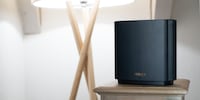
Product test
The Asus ZenWiFi AX speed test: how good is a mesh router without a mesh?
by Martin Jud
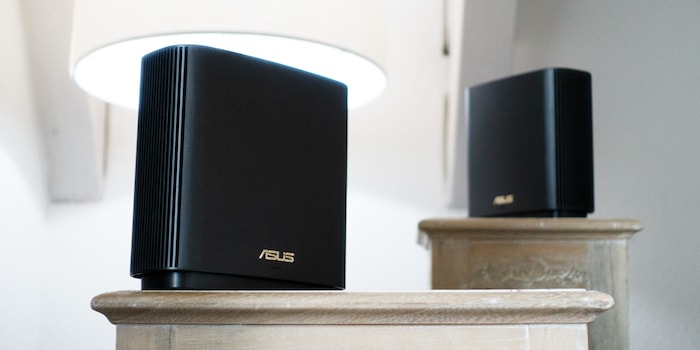
Prepare for trouble, and make it double: how much better does Asus' ZenWiFi tri-band AX mesh setup perform when compared to single-use? Is it better than Swisscom's mesh system?
The ZenWiFi AX is the first router not by an internet provider to be tested in my new flat. This carries some advantages with it. Such as more settings and features. It also gives you independence, so you won't lose your network infrastructure if you should one day change providers. I already checked out how the router performs in single operation.
This week, we'll be examining how good two ZenWiFi AXs are at creating a Wi-Fi mesh using a wireless uplink. The router is available in a dual pack or stand-alone if you're interested.
The specifications of a single router:
Two attics, 140 m² living space and two routers. Check out the flat's floor plan below to see where they're placed. As in my first test, one router is placed in room 3. Right where the most central cable connection of the flat is located. For the second, I chose a location on the floor below where the reception strength is best according to results from my individual test. From now on, I'll always place the second device for mesh systems here – for accurate comparisons.
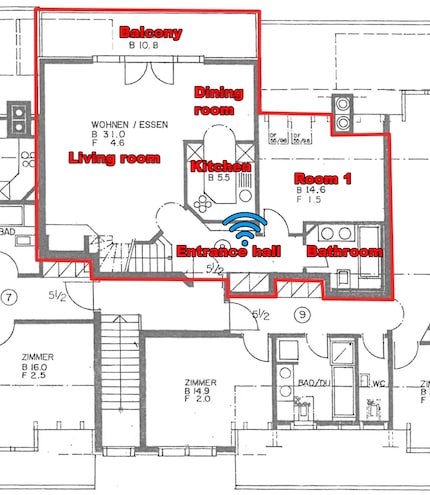
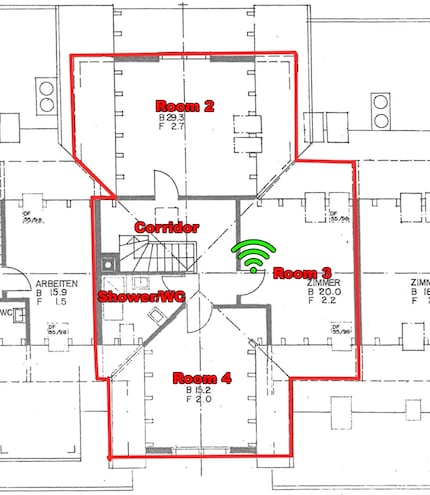
If you're thinking about getting a new router, I'd recommend a mesh-capable device. One network can be extended with a second router. In contrast to a repeater, a mesh router doesn't just pass on a signal, but creates a second decentralized radio network that works in conjunction with the first. To operate a mesh system, at least two devices are required. One with WAN connection at the modem. The second located somewhere on the floor below or above. This should be around where the signal for the first device is strongest.
The second device doesn't necessarily require Internet access via a second LAN cable. It connects to the first one by radio. However, the mesh isn't just operated via a 5 GHz backhaul, but also via a LAN cable if required. With a wired uplink, the power of individual mesh routers on each floor can be fully utilised. This means that the 5 GHz bandwidths, which are used for communication between the two devices in normal mesh operation, are also available.
But enough about wired mesh networks. This article deals with how much Wi-Fi speeds increase with the addition of a second router to create a mesh system.
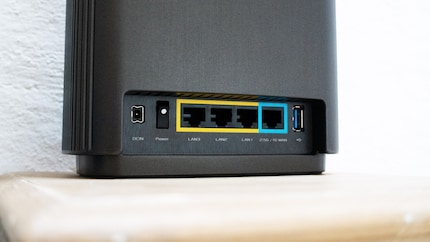
Four RJ45 ports are available to connect the routers and any other network devices: one 2.5 Gigabit WAN port and three Gigabit LAN ports. A USB 3.1 port type A is also available.
By the way, putting two routers into operation is just as easy as setting up one. The Asus Router App, available for Android and iOS, allows for additional AiMesh devices to be integrated. Alternatively, you can also use the web interface. To integrate a new Ai-capable device, it must be within sight and within three meters of the first device.
In order to find out the new mesh Wi-Fi speeds in Mbps, I used «LAN Speed Test». More importantly, the measurement has to be done with a Wi-Fi 6 capable notebook. It also requires a sufficiently fast recipient with which large files are exchanged. An SSD connected as network storage is suitable here – or just use a NAS like I did.
To determine latency, I pinged my NAS in the DOS console. For the signal strength, which is specified in decibel milliwatts (dBm), I used the «NetSpot» software. The heat maps further down were also provided by NetSpot.
The Asus ZenWiFi AX mesh performed as follows:
| Location | 5 GHz frequency
speed/ ping/ signal strength | 2.4 GHz frequency
speed/ ping/ signal strength |
|---|---|---|
| Entrance hall | 403,54 Mbps / 3 ms / -47 dBm | 165,63 Mbps / 3 ms / -43 dBm |
| Living room | 369,18 Mbps / 4 ms / -64 dBm | 124,99 Mbps / 4 ms / -59 dBm |
| Dining room | 375,33 Mbps / 4 ms / -64 dBm | 156,81 Mbps / 4 ms / -52 dBm |
| Kitchen | 378,62 Mbps / 4 ms / -62 dBm | 149,05 Mbps / 4 ms / -48 dBm |
| Balcony | 228,74 Mbps / 5 ms / -75 dBm | 113,15 Mbps / 4 ms / -66 dBm |
| Room 1 | 394,79 Mbps / 4 ms / -55 dBm | 159,92 Mbps / 3 ms / -58 dBm |
| Bathroom | 351,46 Mbps / 3 ms / -53 dBm | 155,36 Mbps / 3 ms / -55 dBm |
| Corridor | 736,91 Mbps / 3 ms / -52 dBm | 157,38 Mbps / 3 ms / -53 dBm |
| Room 2 | 448,25 Mbps / 3 ms / -57 dBm | 100,19 Mbps / 3 ms / -62 dBm |
| Room 3 | 761,64 Mbps / 2 ms / -39 dBm | 166,24 Mbps / 2 ms / -51 dBm |
| Room 4 | 539,08 Mbps / 3 ms / -58 dBm | 105,87 Mbps / 3 ms / -64 dBm |
| Shower/WC | 620,73 Mbps / 3 ms / -54 dBm | 122,66 Mbps / 3 ms / -59 dBm |
| Ø | 467,36 Mbps / 3 ms / -57 dBm | 139,77 Mbps / 3 ms / -56 dBm |
The signal strength for both frequencies is high. In the 5 GHz range, the average is a very good -57 dBm. Reception strength in the most problematic testing zone, the balcony, is just about okay at -75 dBm – at 228.74 Mbps, a considerable amount of data per second still gets through. Four UHD Blu-ray streams or nine UHD Netflix streams could in theory find their way to end devices. Spread over 140 m², you can surf with an average of 467.36 Mbps and a ping of 3 ms.
At -56 dBm, the 2.4 GHz frequency range appears just as stable at first glance. But on closer inspection, you'll notice that it performs even better in terms of coverage. Even on the balcony, the signal still reaches -66 dBm. Average latency in the apartment is 139.77 Mbps at 3 ms.
In contrast to the heat maps for the single router test, the current ones don't contain any deep blue blobs. Yellow, green and turquoise provide sufficient signal strength for the entire flat.

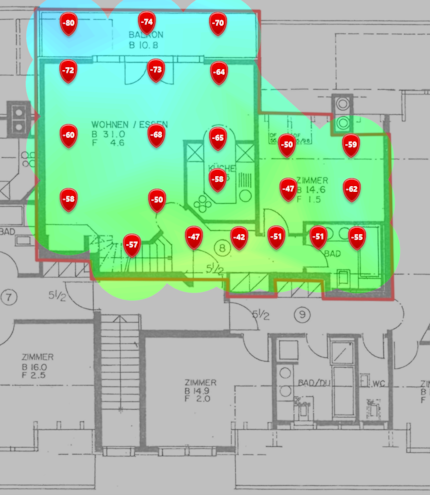
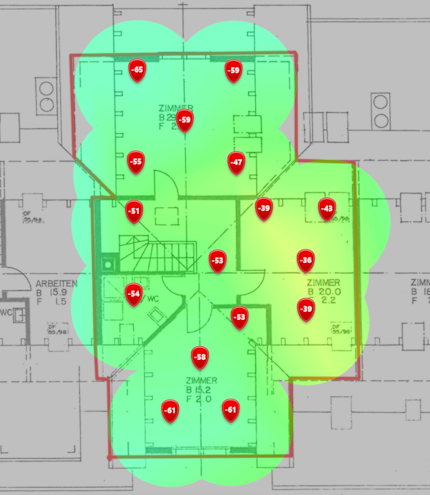
At no point does the 2.4 GHz signal drop below -72 dBm, which is really remarkable. This is what every 2.4 GHz Wi-Fi should look like.

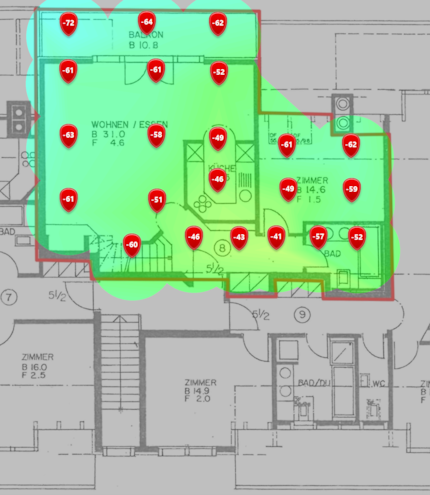
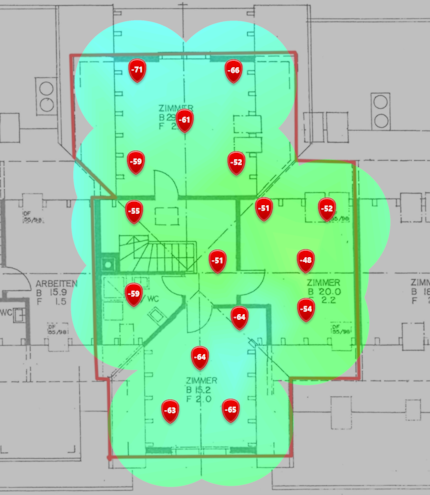
The two routers achieve an average increase of almost 100 Mbps in the 5 GHz frequency range compared to the single operation. Signal strength increases to -57 dBm by a whopping 15 dBm with an equally good latency of 3 ms. The Asus routers perform more or less as Swisscom's Mesh Wi-Fi does – still, the latter is a little bit faster and can therefore keep the 5 GHz Wi-Fi speed test crown for the time being.
The 5 GHz comparison:
| Location | Asus Mesh: 2 x ZenWiFi AX (Wi-Fi 6) | Asus ZenWiFi AX (Wi-Fi 6) | Swisscom Mesh-Wi-Fi (Wi-Fi 6) | Swisscom Internet-Box 3 (Wi-Fi 6) | UPC Connect Box (Wi-Fi 5) |
|---|---|---|---|---|---|
| Entrance hall | 403,54 Mbps / 3 ms / -47 dBm | 391,82 Mbps / 3 ms / -70 dBm | 415,33 Mbps / 3 ms / -40 dBm | 458,23 Mbps / 2 ms / -64 dBm | 121,36 Mbps / 4 ms / -73 dBm |
| Living room | 369,18 Mbps / 4 ms / -64 dBm | 112,90 Mbps / 4 ms / -84 dBm | 392,59 Mbps / 4 ms / -59 dBm | 155,35 Mbps / 4 ms / -78 dBm | 31,71 Mbps / 12 ms / -76 dBm |
| Dining room | 375,33 Mbps / 4 ms / -64 dBm | 65,74 Mbps / 4 ms / -84 dBm | 390,04 Mbps / 4 ms / -58 dBm | 127,94 Mbps / 5 ms / -83 dBm | 0 Mbps / no ping/ -82 dBm |
| Kitchen | 378,62 Mbps / 4 ms / -62 dBm | 136,13 Mbps / 3 ms / -81 dBm | 396,55 Mbps / 3 ms / -55 dBm | 240,57 Mbps / 3 ms / -75 dBm | 0 Mbps / no ping/ -81 dBm |
| Balcony | 228,74 Mbps / 5 ms / -75 dBm | 0 Mbps / no ping/ -89 dBm | 238,47 Mbps / 4 ms / -70 dBm | 0 Mbps / no ping/ -92 dBm | 0 Mbps / no ping/ -83 dBm |
| Room 1 | 394,79 Mbps / 4 ms / -55 dBm | 211,47 Mbps / 4 ms / -77 dBm | 396,21 Mbps / 3 ms / -54 dBm | 357,59 Mbps / 3 ms / -71 dBm | 23,49 Mbps / 14 ms / -78 dBm |
| Bathroom | 351,46 Mbps / 3 ms / -53 dBm | 260,83 Mbps / 4 ms / -70 dBm | 378,08 Mbps / 3 ms / -55 dBm | 382,80 Mbps / 3 ms / -71 dBm | 85,84 Mbps / 5 ms / -75 dBm |
| Corridor | 736,91 Mbps / 3 ms / -52 dBm | 705,92 Mbps / 3 ms / -62 dBm | 743,90 Mbps / 2 ms / -48 dBm | 718,72 Mbps / 2 ms / -47 dBm | 456,66 Mbps / 5 ms / -55 dBm |
| Room 2 | 448,25 Mbps / 3 ms / -57 dBm | 470,08 Mbps / 3 ms / -70 dBm | 461,16 Mbps / 3 ms / -63 dBm | 446,76 Mbps / 3 ms / -64 dBm | 384,16 Mbps / 5 ms / -63 dBm |
| Room 3 | 761,64 Mbps / 2 ms / -39 dBm | 828,41 Mbps / 2 ms / -44 dBm | 823,72 Mbps / 2 ms / -40 dBm | 795,61 Mbps / 2 ms / -38 dBm | 492,58 Mbps / 3 ms / -46 dBm |
| Room 4 | 539,08 Mbps / 3 ms / -58 dBm | 593,26 Mbps / 3 ms / -70 dBm | 492,75 Mbps / 3 ms / -60 dBm | 475,07 Mbps / 3 ms / -60 dBm | 432,33 Mbps / 4 ms / -55 dBm |
| Shower/WC | 620,73 Mbps / 3 ms / -54 dBm | 651,75 Mbps / 2 ms / -59 dBm | 656,87 Mbps / 2 ms / -55 dBm | 628,98 Mbps / 2 ms / -54 dBm | 382,73 Mbps / 4 ms / -57 dBm |
| Ø | 467,36 Mbps / 3 ms / -57 dBm | 369,03 Mbps / 3 ms* / -72 dBm | 482,14 Mbps / 3 ms / -55 dBm | 398,97 Mbps / 3 ms* / -66 dBm | 200,91 Mbps / 6 ms* / -69 dBm |
* Average value of rooms that have a signal.
The 2.4 GHz Wi-Fi speed test crown is snatched up by Asus, with an average latency of only 3 ms. The speed and network coverage are also a bit better. Compared to the single ZenWiFi AX, which operates at eye level with the Swisscom mesh, there's a roughly equal speed boost of around 24 Mbps.
The 2.4 GHz comparison:
| Location | Asus Mesh: 2 x ZenWiFi AX (Wi-Fi 6) | Asus ZenWiFi AX (Wi-Fi 6) | Swisscom Mesh-Wi-Fi (Wi-Fi 6) | Swisscom Internet-Box 3 (Wi-Fi 6) | UPC Connect Box (Wi-Fi 5) |
|---|---|---|---|---|---|
| Entrance hall | 165,63 Mbps / 3 ms / -43 dBm | 144,65 Mbps / 3 ms / -54 dBm | 148,02 Mbps / 4 ms / -44 dBm | 135,46 Mbps / 3 ms / -64 dBm | 64,87 Mbps / 6 ms / -66 dBm |
| Living room | 124,99 Mbps / 4 ms / -59 dBm | 77,29 Mbps / 4 ms / -67 dBm | 112,12 Mbps / 5 ms / -58 dBm | 48,98 Mbps / 5 ms / -77 dBm | 52,30 Mbps / 7 ms / -69 dBm |
| Dining room | 156,81 Mbps / 4 ms / -52 dBm | 83,16 Mbps / 3 ms / -66 dBm | 111,37 Mbps / 5 ms / -63 dBm | 54,61 Mbps / 5 ms / -75 dBm | 31,81 Mbps / 8 ms / -74 dBm |
| Kitchen | 149,05 Mbps / 4 ms / -48 dBm | 132,74 Mbps / 4 ms / -65 dBm | 126,56 Mbps / 4 ms / -56 dBm | 128,03 Mbps / 3 ms / -65 dBm | 28,43 Mbps / 8 ms / -76 dBm |
| Balcony | 113,15 Mbps / 4 ms / -66 dBm | 25,33 Mbps / 5 ms / -80 dBm | 80,81 Mbps / 5 ms / -72 dBm | 16,52 Mbps / 12 ms / -85 dBm | 16,71 Mbps / 11 ms / -80 dBm |
| Room 1 | 159,92 Mbps / 3 ms / -58 dBm | 118,02 Mbps / 3 ms / -59 dBm | 112,98 Mbps / 4 ms / -63 dBm | 106,37 Mbps / 4 ms / -65 dBm | 46,17 Mbps / 7 ms / -69 dBm |
| Bathroom | 155,36 Mbps / 3 ms / -55 dBm | 130,47 Mbps / 4 ms / -54 dBm | 110,25 Mbps / 4 ms / -61 dBm | 108,42 Mbps / 3 ms / -71 dBm | 63,25 Mbps / 6 ms / -65 dBm |
| Corridor | 157,38 Mbps / 3 ms / -53 dBm | 163,09 Mbps / 3 ms / -57 dBm | 135,74 Mbps / 3 ms / -58 dBm | 150,74 Mbps / 2 ms / -54 dBm | 87,12 Mbps / 5 ms / -57 dBm |
| Room 2 | 100,19 Mbps / 3 ms / -62 dBm | 101,68 Mbps / 3 ms / -58 dBm | 96,16 Mbps / 4 ms / -64 dBm | 88,33 Mbps / 4 ms / -70 dBm | 72,68 Mbps / 7 ms / -60 dBm |
| Room 3 | 166,24 Mbps / 2 ms / -51 dBm | 171,96 Mbps / 2 ms / -41 dBm | 169,53 Mbps / 2 ms / -43 dBm | 176,88 Mbps / 2 ms / -45 dBm | 93,54 Mbps / 4 ms / -41 dBm |
| Room 4 | 105,87 Mbps / 3 ms / -64 dBm | 110,72 Mbps / 3 ms / -60 dBm | 94,09 Mbps / 4 ms / -64 dBm | 86,32 Mbps / 4 ms / -64 dBm | 91,09 Mbps / 6 ms / -55 dBm |
| Shower/WC | 122,66 Mbps / 3 ms / -59 dBm | 127,81 Mbps / 3 ms / -54 dBm | 109,47 Mbps / 3 ms / -58 dBm | 103,29 Mbps / 3 ms / -60 dBm | 89,96 Mbps / 6 ms / -55 dBm |
| Ø | 139,77 Mbps / 3 ms / -56 dBm | 115,58 Mbps / 3 ms / -60 dBm | 117,26 Mbps / 4 ms / -59 dBm | 100,33 Mbps / 4 ms / -66 dBm | 61,49 Mbps / 7 ms / -64 dBm |
The ZenWiFi AX has already made its case as a single router. And Asus isn't slacking when it comes to mesh systems either. On the contrary: a mesh covers any blind spots and gives you a powerful connection wherever you are. The heat maps illustrate that my apartment could be a bit bigger. My neighbour to the right of the flat should be able to receive my mesh without any problems.
Asus Mesh is on par with the already tested Swisscom Mesh in terms of speed. In the 5 GHz range, the difference is only 15 Mbps, with Swisscom beating out Asus. In return, the Asus 2.5 GHz range performs better by 24 Mbps
All in all, ZenWiFi AX is a recommendable mesh in dual mode, which not only provides sufficient performance but also has many customisation options. Besides, the design is very pleasing. For router conditions, the hardware is kept compact. There are no visible antennas.
I find my muse in everything. When I don’t, I draw inspiration from daydreaming. After all, if you dream, you don’t sleep through life.